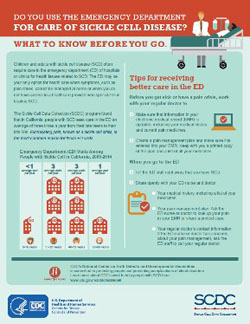 Children and adults with sickle cell disease (SCD) often require care in the emergency department (ED) for health issues, such as severe SCD-related pain. Before you find yourself in the ED, work with your regular doctor to create a pain management plan and make sure it is entered into your electronic medical record (EMR). When you go to the ED, share openly with your ED nurse or doctor your medical history and pain management plan.
Children and adults with sickle cell disease (SCD) often require care in the emergency department (ED) for health issues, such as severe SCD-related pain. Before you find yourself in the ED, work with your regular doctor to create a pain management plan and make sure it is entered into your electronic medical record (EMR). When you go to the ED, share openly with your ED nurse or doctor your medical history and pain management plan.
Sickle cell disease (SCD) is an inherited blood disorder that can run in families, is present at birth, and affects approximately 100,000 people in the United States. Common health problems related to SCD include severe pain known as a sickle cell crisis, infection, lung-related complications, and stroke.
How often do people with SCD go to the ED?
The Sickle Cell Data Collection (SCDC) program found that people with SCD living in California go to the ED within hospitals and clinics an average of 3 times a year during their late teens and continue this pattern into their late 50s. A Tennessee study reported that African Americans with SCD go to the ED two to six times more often than African Americans without SCD.
 Why do people with SCD go to the ED?
Why do people with SCD go to the ED?
People with SCD often seek care in the ED when their health problems cannot be treated at home or when they do not have access to a doctor who specializes in treating SCD. Excruciating pain, known as a sickle cell crisis, is the most common health problem among people with SCD and the top reason for going to the ED. Many patients require high doses of pain medicines to treat their sickle cell crises.
What challenges may people with SCD encounter in the ED?
People with SCD may face long wait times before seeing a health provider in the ED and before receiving appropriate medicines. Health providers in the ED may hold inaccurate beliefs about patients with SCD. Research shows that ED providers may suspect patients with SCD to be drug-seeking when they arrive in the ED.
Tips for Better Care in the ED
People with SCD can take simple steps that may help them receive care in the ED more quickly and efficiently:
Before you get sick or have a pain crisis, work with your regular doctor to:
- Make sure that information in your EMR is updated, including your medical history and current pain medicines.
- Create a pain management plan and make sure it is entered into your EMR. Keep with you a printed copy of the plan and a list of all your medicines.
When you go to the ED:
- Tell the ED staff right away that you have SCD.
- Share openly with your ED nurse and doctor.
- Your medical history, including a list of your medicines.
- Your pain management plan. Ask the ED nurse or doctor to look up your plan in your EMR or share a printed copy.
- Your regular doctor’s contact information. If the ED nurse or doctor has concerns about your pain management, ask the ED staff to call your regular doctor.
Courtesy of Centers for Disease Control and Prevention









